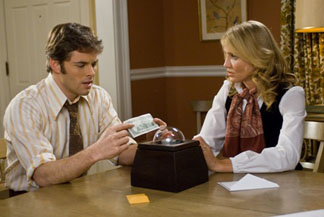|
|
Book vs. Movie: The BoxBy Russ BickerstaffNovember 9, 2009
The Box Presumably at some point in the late 1960s, author Richard Matheson (the man behind the original novels I Am Legend and What Dreams May Come) had a brilliant little idea for a short story involving a married couple, a button, a large sum of money and a moral dilemma. The story, which was titled Button, Button, was clever enough to be published in Playboy Magazine in 1970, one of the highest-paying publishers of short stories at the time. Button, Button went on to appear in a 1970 collection of short stories named in its honor. Over a decade and a half later, the story was featured in the first season of the mid-1980s revival of CBS's Twilight Zone series. Now it's been picked up and turned into a major motion picture, written and directed by Richard Kelly and starring Cameron Diaz, James Marsden and Frank Langella. The story, the TV episode and the film vary considerably. How do the three compare? The Printed Story Weighing in somewhere in the neighborhood of 2,800 words (roughly the length of this column) the story is short and breezy. The tale opens by introducing all of the basic elements: There's a small, cube-shaped carton sealed with tape on the doorstep of Arthur and Norma Lewis. The Lewises live on 217 East 37th street in New York. The carton is opened to reveal a small, wooden box with a button on it. The button rests beneath a glass dome which has been locked in place. There's a note taped to the bottom of the box notifying the Lewises that a man will be by at 8 p.m. - presumably to explain what the box is about. And a man does, in fact, come by to explain the box and hand the Lewises a key to the box. If they open the box and press the button, two things will happen. First: someone they don't know will die. Second: They will receive $50,000. Once the gentleman leaves, the couple discusses the possibility of pushing the button. She's intrigued. He's disgusted. The next day at work, she decides to give the mysterious man a call (he'd left his card). She asks him a few questions. He answers them. On her way back home, she sees that the box is still resting there and, after thinking it over, she decides to press the button. She tells Arthur that she did as much, explaining that she wasn't being selfish. Yes, someone would die, but they would have the opportunity to buy a house, take a vacation and possibly have that baby they'd always wanted. He doesn't say much. Presumably he still feels it's a sick joke or some kind of weird behavioral research, theories he'd voiced in their initial conversation about the button.
[ View other columns by Russ Bickerstaff ]
[ View other Book vs. Movie columns ]
[ Email this column ]
|

|
|
|

|
Friday, November 1, 2024
© 2024 Box Office Prophets, a division of One Of Us, Inc.


